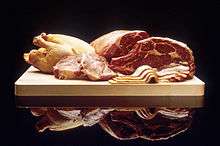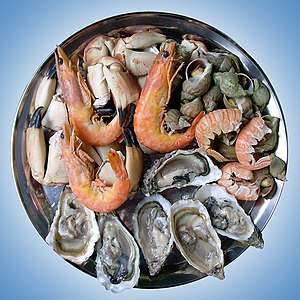Meat tenderness
Tenderness is a quality of meat gauging how easily it is chewed or cut. Tenderness is a desirable quality, as tender meat is softer, easier to chew, and generally more palatable than harder meat. Consequently, tender cuts of meat typically command higher prices. The tenderness depends on a number of factors including the meat grain, the amount of connective tissue, and the amount of fat.[1] Tenderness can be increased by a number of processing techniques, generally referred to as tenderizing or tenderization.
Influencing factors
Tenderness is perhaps the most important of all factors impacting meat eating quality, with others being flavor, juiciness, and succulence.[2]
Tenderness is a quality complex to obtain and gauge, and it depends on a number of factors. On the basic level, these factors are meat grain, the amount and composition of connective tissue, and the amount of fat.[1] In order to obtain a tender meat, there is a complex interplay between the animal's pasture, age, species, breed, protein intake, calcium status, stress before and at killing, and how the meat is treated after slaughter.[3]
Meat with the fat content deposited within the steak to create a marbled appearance has always been regarded as more tender than steaks where the fat is in a separate layer.[3] Cooking causes melting of the fat, spreading it throughout the meat and increasing the tenderness of the final product.[1]
Testing
The meat industry strives to produce meat with standardized and guaranteed tenderness, since these characteristics are sought for by the consumers.[4] For that purpose a number of objective tests of tenderness have been developed, gauging meat resistance to shear force, most commonly used being Slice Shear Force test[5] and Warner–Bratzler Shear Force test.[6]
Tenderising
Techniques for breaking down collagens in meat to make it more palatable and tender are referred to as tenderizing or tenderization.
There are a number of ways to tenderize meat:
- Mechanical tenderization, such as pounding,[7] or piercing.[7]
- The tenderization that occurs through cooking, such as braising.[8]
- Tenderizers in the form of naturally occurring enzymes, which can be added to food before cooking.[7]
- Marinating the meat with vinegar, wine, lemon juice, buttermilk or yogurt.[7]
- Brining the meat in a salt solution (brine).[7]
- Dry aging of meat at 0 to 2 °C (32 to 36 °F).[8]
- Velveting
- Sodium bicarbonate[9]
Research
Efforts have been made since at least 1970 to use explosives to tenderize meat and a company was founded to try to commercialize the process; as of 2011 it was not yet scalable.[10]
References
- "Meat processing : Meat Qualities". Britannica. Retrieved 17 March 2016.
- Troy, D.J.; Kerry, J.P. (2010). "Consumer perception and the role of science in the meat industry". Meat Science. 86 (1): 214–226. doi:10.1016/j.meatsci.2010.05.009. PMID 20579814.
- "The Meat Tenderness Debate". Natural Hub. Retrieved 17 March 2016.
- Luciano, F. B.; Anton, A.A; Rosa, C.F. (2007). "BIOCHEMICAL ASPECTS OF MEAT TENDERNESS: A BRIEF REVIEW" (PDF). Arch. Zootec. (56 (R): 1–8).
- Shackelford, S. D.; Wheeler, Ph.D., T. L. (2009). "Slice Shear Force" (PDF). Centennial, Colorado: National Cattlemen’s Beef Association USDA-ARS.
- Wheeler, Tommy L.; Shackelford, Steven D.; Koohmaraie USDA-ARS, Mohammad. "Warner-Bratzler Shear Force Protocol" (PDF). U.S. Meat Animal Research Center.
- McGee, Harold (2004). ON FOOD AND COOKING, The science and lore of the kitchen. Scribner. p. 155. ISBN 978-0-684-80001-1.
- LAROUSSE Gastronomique. Hamlyn. 2000. p. 1204. ISBN 978-0-600-60235-4.
- https://www.cooksillustrated.com/how_tos/6707-tenderizing-meat-with-a-baking-soda-solution
- Abrahams, Marc (5 December 2011). "Best way to tenderise meat? An underwater explosion". The Guardian.
See also

External links
- Improving Meat Tenderness by John Marchello and Ron Allen


